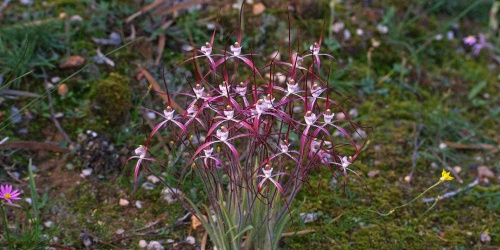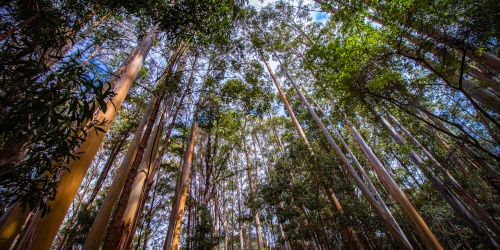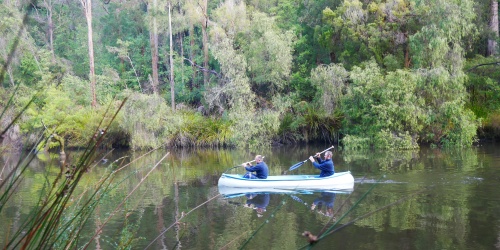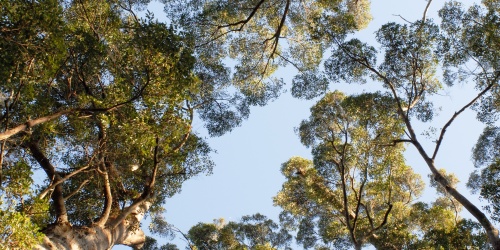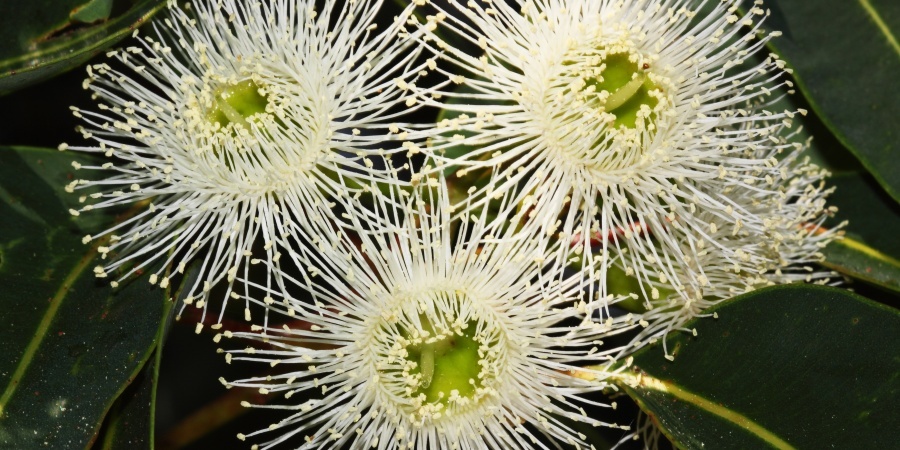
South-west forests are valued for many reasons. These forests:
- provide habitat for plants and animals, and support diverse ecosystems
- are the water supply catchment areas for most of Western Australia's population
- are the source of our main native timber industries
- provide a major recreation and tourism drawcard
- have a rich heritage
Forest health
The health of the forest can be affected by:
- lightning strikes and bushfires
- climate change
- weeds, pests and diseases
- disturbances such as timber harvesting or land clearing.
Protecting and maintaining a healthy forest
Healthy ecosystems are more resistant to pressures such as climate change, so maintaining forest ecosystem health and vitality is important.
- DBCA does this through a range of measures, including:
- planning, implementing and reviewing the prescribed burning program
- maintaining Western Shield, the biggest wildlife conservation program undertaken in Australia
- maintaining surveillance and recording systems for forest diseases
- providing greater protection to trees or groups of trees that show resistance to pests or disease during timber harvesting operations - this helps maintain the health of the areas where these trees occur and provides breeding stock to re-populate affected areas.
- regulating the use of heavy vehicles to protect soil during timber harvesting and other disturbance operations
- prioritising research and management efforts for pests and diseases to identify outbreaks of high impact weeds that are still small enough to eradicate or contain, and areas of high conservation value where weed control is likely to have the greatest benefit
- a coordinated approach by all land managers, owners and users because most threats to forest health cross property boundaries
- rehabilitation of native vegetation cleared during planned disturbance operations, such as mining and extraction of basic raw materials
Pests and diseases in our forests
Western Australia, together with other states and territories reports on recognised pests and diseases within state managed forests and plantations.
The scale and impact of agents and processes affecting forest health and vitality are reported in Australia's State of the Forests Report by the Australian Government with input from the State.
In Western Australia, a range of insect groups and species are used by forest managers useful indicators of forest ecosystem health and vitality.
- Forest insects in Western Australia are categorised by how they feed:
- predators
- parasites
- detritivores
- herbivores.
Insects seen as pests in forests are generally herbivores, and include leaf chewers, sap suckers and wood/stem/root feeders.
A poster of common insect pests in WA's southern jarrah forests can be downloaded from the bottom of this page.
You can also find information on this website about plant diseases and weeds.
Reserves and protected areas
To maintain biodiversity, we need to create a network of protected areas (reserves) of forest communities, individual species and genetic diversity within species. These reserves also protect habitat, evolutionary processes and systems that support ecological processes.
Reserves such as national parks and nature reserves are created under legislation and generally require parliamentary approval to change them. For these reasons they are referred to as formal conservation reserves.
A forest management plan can establish informal reserves for conservation within State forest and timber reserves for the life of that plan.
Just under 2.3 million hectares of native forest in our State's south-west region is on lands managed by DBCA.
The main types of informal reserves are:
- old-growth forest, protecting all old-growth forest that is not in formal reserves
- river and stream zones, protecting corridors of vegetation along rivers and streams
- travel route zones, protecting corridors of vegetation along designated roads and the Bibbulmun Track and Munda Biddi Trail for their aesthetic and social values as well as protecting biodiversity
- diverse ecotype zones, protecting sensitive ecosystems such as rock outcrops and wetlands.
The Conservation and Land Management Act 1984 also provides for forest conservation areas to be proposed. These provide a higher level of security of classification than informal reserves and are used for areas that have some impediment (such as mineral resources) to being considered for a formal reserve category. Forest conservation areas are managed for their biodiversity values and are not available for timber harvesting, but other uses may be permitted, such as wildflower picking, beekeeping, craftwood and firewood collection.
Old-growth forests
Old‑growth forest is ecologically mature forest where the effects of unnatural disturbance are now negligible.
Areas of old-growth forest were initially mapped for the Regional Forest Agreement (RFA) through the Comprehensive Regional Assessment process undertaken to prepare Western Australia’s RFA.
All old-growth forests in the south west have been protected from timber harvesting since 2001. Over 334,000 hectares of old-growth forest has been identified, with around 93 per cent protected in existing or proposed national parks, conservation parks or nature reserves. The remaining 7 per cent of mapped old-growth forest is protected through the establishment of informal reserves under the Forest Management Plan 2014-2023.
The current location and extent of old-growth forests is depicted in the download below, which is updated annually, and also identifies any changes in the extent of old-growth forest status.
Nominating an area of previously unmapped old‑growth forest
Although much work has been done to map all known areas old-growth forest, new areas are still being found. The community can nominate areas of forest which may meet the criteria to be recognised as old-growth forest.
To nominate an area of forest that you believe may contain previously unmapped old-growth forest a public nomination form should be filled out and submitted to DBCA. Please ensure all the details specified in the form are completed to ensure that processing commences as quickly as possible.
Following acceptance of the nomination an assessment of the area is conducted, additional old-growth forest identified will be added to the estate. Reports on public nominations to review the status of old-growth forest are listed below.
Gathering domestic firewood
Collecting firewood for personal use is permitted in some forest areas managed by DBCA. Visit our firewood pages for more information.
Minerals and other basic raw materials
Mineral and petroleum operations in forest areas provide significant economic and social benefits to Western Australia. State forest and timber reserves also contain supplies of gravel, shale, clay, sand, limestone and rock that together are known as basic raw materials (BRM).
Mining operations in Western Australia’s south-west native forests
Mining and associated operations usually involve significant modification of the environment. Operations are approved and largely governed under legislation administered by other government agencies, including the Environmental Protection Act 1986, the Mining Act 1978 and State Agreements Acts. DBCA seeks to minimise the lasting impact of these operations by having input into approvals and rehabilitation.
Mining for tin commenced near Greenbushes in 1888 and coal near Collie in the 1890s. From the 1960s mining in Western Australia’s publicly owned south-west native forest increased with the advent of bauxite mining near Jarrahdale. Today there are several large-scale mining operations in these forests, including mining for bauxite, coal, mineral sands, tantalum and lithium.
Mining operations are planned and managed to avoid, where possible, significant effects on other forest uses. When mining has been completed, disturbed areas are rehabilitated and, if practical reintegrated into the forest estate. If rehabilitation to meet a standard suitable for return to State forest is not possible, the Conservation and Parks Commission and DBCA may seek alternative areas of forest to offset the loss of mined forest.
Basic raw materials
Basic raw materials (BRM) are used for road making and building. BRM from State forest and timber reserves are provided to government agencies and local governments through leases issued under section 97 of the Conservation and Land Management Act 1984.
DBCA uses BRM in recreation and management activities and facilitates its supply for timber harvesting undertaken by the Forest Products Commission.
The Forest Management Plan 2014-2023 outlines management activities which seek to minimise the areas affected and the potential for other adverse environmental impacts.
Fauna habitat zones
Fauna (animal) habitat zones are a network of areas across the forest landscape excluded from timber harvesting.
They provide a refuge for animals vulnerable to disturbance and, in the medium term, as a source of animals that can return to live in harvested areas as they regenerate.
Fauna habitat zones help meet the Forest Management Plan objective of ensuring that biodiversity recovers between one timber harvest and the next.
The fauna habitat zones are carefully selected to include a broad range of soil and landform types similar to those in the existing formal conservation reserve system. This helps establish and maintain a diverse range of habitats, and several stages of growth and regeneration.
Selection and managing fauna habitat zones are guided by:
- Guidelines for the Selection of Fauna Habitat Zones (2017)
- Guidelines for Protection of the Values of Informal Reserves and Fauna Habitat Zones (2009).
Request copies of these guidelines by emailing DBCA.
Climate change and the management of our forests
In south-western Western Australia, the impact of climate change is most apparent in a substantial drying trend, with significant decreases in rainfall, streamflow and groundwater levels since the mid-1970s in the last 40 years.
In the northern jarrah forest there has been a 15 per cent reduction in rainfall since the mid-1970s, resulting in some tree deaths, and negatively affecting water dependent ecosystems throughout the forest.
DBCA, in recognition of the possible impacts of climate change on native forest ecosystems and processes, will manage our State forest and timber reserves to support and promote mitigation of climate change, and the adaptation of forest ecosystems and their elements to climate-related changes, consistent with the principles of ecologically sustainable forest management
Soil and water
Soil
Soils, and the organic matter they contain, provide the physical, chemical and biological foundation necessary to support plant and animal life, and sustain ecological processes.
- Soils affect how native plants grow, and consequently the habitats necessary for native animals
- Soils store and regulate the supply of nutrients and water essential for plant growth and development
- Soils contain micro-organisms which regulate the supply of nutrients essential for the maintenance of healthy ecosystems
- Uncultivated soils make positive contributions to global carbon cycles.
Soil disturbance, erosion, compaction and salinity can negatively affect soil carbon and fertility, and ecosystem and hydrological processes.
Disturbance to vegetation from mining, prescribed burning, road building, timber harvesting, pest animals and grazing can cause soil erosion, and may result in lower soil fertility and build up of sediments in rivers. Even small losses of soil are important and should be minimised.
Soil bulk density is a measure of the soil's physical properties that is important for fertility and hydrological processes. Soil-bound organic matter and above-ground organic debris are important to soil fertility because they contribute to the physical, chemical and biological properties of soil.
The protection of soil during timber harvesting and other activities in our State's south-west native forests is an important management activity as per the Forest Management Plan 2014-2023.
Water
Water is an essential commodity for people, communities and various industries, and the quality of water determines how it is used.
Western Australia's south-west forests provide catchment areas for drinking water for most of the State's population, and water sources for recreation and industry.
- Surface and groundwater supply, demand for its use and water quality are all considered in preparing the Forest Management Plan 2014-2023.
- Since at least the 1970s, climate change has created a shift to warmer and drier conditions across the south-west forests, leading to reduced streamflow and runoff.
- At the same time, population growth, mining, agriculture and horticulture in Western Australia are increasing the demand for water. This growth will also mean increased demand for recreation in public drinking water catchments.
- A 2009 study by the CSIRO found the available surface water supply by 2030 was expected to drop around a quarter from the period 1975 to 2007, and groundwater supply was also expected to drop by around three per cent, in south-west Western Australia, including the metropolitan area.
- Historically, the main risk to water quality in forested catchments was rising groundwater, which dissolved salt stored in the soil and brought it to the surface (salinity). However, groundwater levels are falling in DBCA's Swan and South West regions and parts of the Warren Region because of reduced rainfall.
With this in mind, the current Forest Management Plan has proposed changes to silvicultural practices, including thinning of vegetation to increase the water available to key areas that depend on surface water, such as important wetlands.
- The maximum area that could be thinned is about 65,500 hectares.
- Modelling for this strategy indicates that an extra 22 gigalitres of water a year could be produced on average for the first decade, and an extra 45 gigalitres a year after that with ongoing forest management.
- Catchment management plans will be required where any proposal seeks to reduce stand density below the relevant silviculture guideline, or where a proposal would change a large proportion of the forest in the catchment to young trees, which may have greater water use than older stages of development.
Timber harvesting will continue to be excluded from informal reserves along streams and rivers to protect water quality. These informal reserves also provide a network of undisturbed corridors through the forest for wildlife.
Forest heritage
Heritage encompasses that which we value and want to protect as a community. It includes cultural and natural heritage.
Natural heritage
Natural heritage is strongly linked to features of the natural environment, such as biodiversity, ecosystems, soil and water. Our majestic south-west forests are an important part of our natural heritage.
Cultural heritage
Noongar people have had a connection to forest areas in the south-west of Western Australia for more than 60,000 years.
This connection and stewardship covers traditional ecological knowledge of land, archaeological records of places and ceremony, and an ongoing physical and spiritual attachment to the land.
South West Native Title Settlement
The South West Native Title Settlement (the Settlement) is the largest and most comprehensive agreement to settle Aboriginal interests over land in Australia. The Settlement, involving six Noongar Native Title Agreement Groups, and covering 200,000 square kilometres of land, represents significant social and economic investment in the Noongar community and the shared future of Western Australia
As part of the Settlement, DBCA and the six Noongar Regional Corporations will enter into Co-operative and Joint Management Agreements for the care and protection of the south-west forests. This partnership will ensure the south-west forests are cared for using Noongar and Western methods.
Amendments to the Conservation and Land Management Act 1984 include protecting and conserving the value of the land to the culture and heritage of Aboriginal people in a way that does not adversely affect the conservation of plants and animals. The amendments also provide for joint management arrangements and will build on existing entitlements to enable Aboriginal people to undertake customary activities, such as preparing and consuming food and engaging in ceremonial activities, on land vested in the Conservation and Parks Commission.
Other cultural heritage
As well as the rich Aboriginal heritage in our south-west forests, there is a wealth of other Australian cultural heritage, including:
- timber towns, buildings and sawmills (such as Shannon)
- transport systems such as old railway lines
- dams and weirs
- tree nurseries
- folklore and traditions.
A range of historic places on lands vested in the Conservation and Parks Commission are:
- listed as Commonwealth Heritage
- included on the State 'Register of Heritage Places'
- included in local government 'Municipal Inventories'
Research - FORESTCHECK
DBCA researchers study, describe, monitor and map the species and ecological communities of Western Australia.
This research provides an increased understanding of the state's plants and animals, ecological processes and biological resources. It focuses on the conservation of biodiversity in Western Australia, and the sustainable use and management of our natural resources, including forests.
FORESTCHECK provides a range of information to forest managers about changes and trends in biodiversity associated with forest activities.
FORESTCHECK:
- makes a significant contribution to forest science
- informs forest managers on changes and trends in key elements of forest biodiversity
- provides a framework for meaningful public participation in forest management
- provides relevant information to allow DBCA to comply with reporting requirements associated with sustainable forest management
